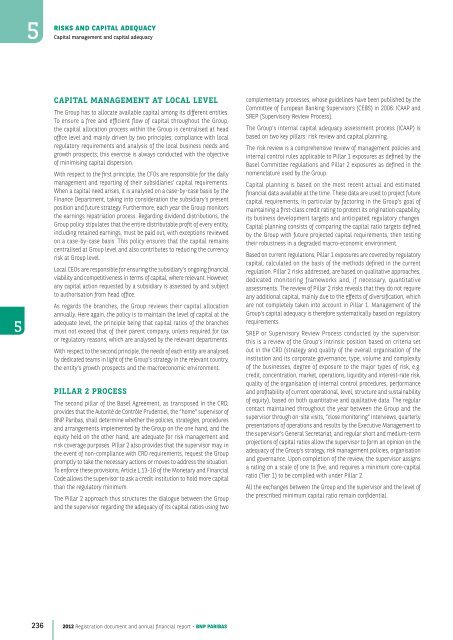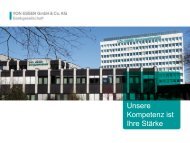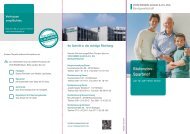2012 Registration document and annual financial report - BNP Paribas
2012 Registration document and annual financial report - BNP Paribas
2012 Registration document and annual financial report - BNP Paribas
- No tags were found...
Create successful ePaper yourself
Turn your PDF publications into a flip-book with our unique Google optimized e-Paper software.
5RISKSAND CAPITAL ADEQUACYCapital management <strong>and</strong> capital adequacy5CAPITAL MANAGEMENT AT LOCAL LEVELThe Group has to allocate available capital among its different entities .To ensure a free <strong>and</strong> efficient flow of capital throughout the Group,the capital allocation process within the Group is centralised at headoffice level <strong>and</strong> mainly driven by two principles: compliance with localregulatory requirements <strong>and</strong> analysis of the local business needs <strong>and</strong>growth prospects; this exercise is always conducted with the objectiveof minimising capital dispersion.With respect to the first principle, the CFOs are responsible for the dailymanagement <strong>and</strong> <strong>report</strong>ing of their subsidiaries’ capital requirements.When a capital need arises, it is analysed on a case-by-case basis by theFinance Department, taking into consideration the subsidiary’s presentposition <strong>and</strong> future strategy. Furthermore, each year the Group monitorsthe earnings repatriation process. Regarding dividend distributions, theGroup policy stipulates that the entire distributable profit of every entity,including retained earnings, must be paid out, with exceptions reviewedon a case-by-case basis. This policy ensures that the capital remainscentralised at Group level <strong>and</strong> also contributes to reducing the currencyrisk at Group level.Local CEOs are responsible for ensuring the subsidiary’s ongoing <strong>financial</strong>viability <strong>and</strong> competitiveness in terms of capital, where relevant. However,any capital action requested by a subsidiary is assessed by <strong>and</strong> subjectto authorisation from head office.As regards the branches, the Group reviews their capital allocation<strong>annual</strong>ly. Here again, the policy is to maintain the level of capital at theadequate level, the principle being that capital ratios of the branchesmust not exceed that of their parent company, unless required for taxor regulatory reasons, which are analysed by the relevant departments.With respect to the second principle, the needs of each entity are analysedby dedicated teams in light of the Group’s strategy in the relevant country,the entity’s growth prospects <strong>and</strong> the macroeconomic environment.PILLAR 2 PROCESSThe second pillar of the Basel Agreement, as transposed in the CRD,provides that the Autorité de Contrôle Prudentiel, the “home” supervisor of<strong>BNP</strong> <strong>Paribas</strong>, shall determine whether the policies, strategies, procedures<strong>and</strong> arrangements implemented by the Group on the one h<strong>and</strong>, <strong>and</strong> theequity held on the other h<strong>and</strong>, are adequate for risk management <strong>and</strong>risk coverage purposes. Pillar 2 also provides that the supervisor may, inthe event of non-compliance with CRD requirements, request the Grouppromptly to take the necessary actions or moves to address the situation.To enforce these provisions, Article L.13-16 of the Monetary <strong>and</strong> FinancialCode allows the supervisor to ask a credit institution to hold more capitalthan the regulatory minimum.The Pillar 2 approach thus structures the dialogue between the Group<strong>and</strong> the supervisor regarding the adequacy of its capital ratios using twocomplementary processes, whose guidelines have been published by theCommittee of European Banking Supervisors (CEBS) in 2006: ICAAP <strong>and</strong>SREP (Supervisory Review Process).The Group’s internal capital adequacy assessment process (ICAAP) isbased on two key pillars: risk review <strong>and</strong> capital planning.The risk review is a comprehensive review of management policies <strong>and</strong>internal control rules applicable to Pillar 1 exposures as defined by theBasel Committee regulations <strong>and</strong> Pillar 2 exposures as defined in thenomenclature used by the Group.Capital planning is based on the most recent actual <strong>and</strong> estimated<strong>financial</strong> data available at the time. These data are used to project futurecapital requirements, in particular by factoring in the Group’s goal ofmaintaining a first-class credit rating to protect its origination capability,its business development targets <strong>and</strong> anticipated regulatory changes.Capital planning consists of comparing the capital ratio targets definedby the Group with future projected capital requirements, then testingtheir robustness in a degraded macro-economic environment.Based on current regulations, Pillar 1 exposures are covered by regulatorycapital, calculated on the basis of the methods defined in the currentregulation . Pillar 2 risks addressed, are based on qualitative approaches,dedicated monitoring frameworks <strong>and</strong>, if necessary, quantitativeassessments. The review of Pillar 2 risks reveals that they do not requireany additional capital, mainly due to the effects of diversification, whichare not completely taken into account in Pillar 1. Management of theGroup’s capital adequacy is therefore systematically based on regulatoryrequirements.SREP or Supervisory Review Process conducted by the supervisor:this is a review of the Group’s intrinsic position based on criteria setout in the CRD (strategy <strong>and</strong> quality of the overall organisation of theinstitution <strong>and</strong> its corporate governance, type, volume <strong>and</strong> complexityof the businesses, degree of exposure to the major types of risk, e.g.credit, concentration, market, operations , liquidity <strong>and</strong> interest-rate risk,quality of the organisation of internal control procedures, performance<strong>and</strong> profitability of current operational , level, structure <strong>and</strong> sustainabilityof equity), based on both quantitative <strong>and</strong> qualitative data. The regularcontact maintained throughout the year between the Group <strong>and</strong> thesupervisor through on-site visits, “close monitoring” interviews, quarterlypresentations of operations <strong>and</strong> results by the Executive Management tothe supervisor’s General Secretariat, <strong>and</strong> regular short <strong>and</strong> medium-termprojections of capital ratios allow the supervisor to form an opinion on theadequacy of the Group’s strategy, risk management policies, organisation<strong>and</strong> governance. Upon completion of the review, the supervisor assignsa rating on a scale of one to five, <strong>and</strong> requires a minimum core-capitalratio (Tier 1) to be complied with under Pillar 2.All the exchanges between the Group <strong>and</strong> the supervisor <strong>and</strong> the level ofthe prescribed minimum capital ratio remain confidential.236<strong>2012</strong> <strong>Registration</strong> <strong>document</strong> <strong>and</strong> <strong>annual</strong> <strong>financial</strong> <strong>report</strong> - <strong>BNP</strong> PARIBAS





